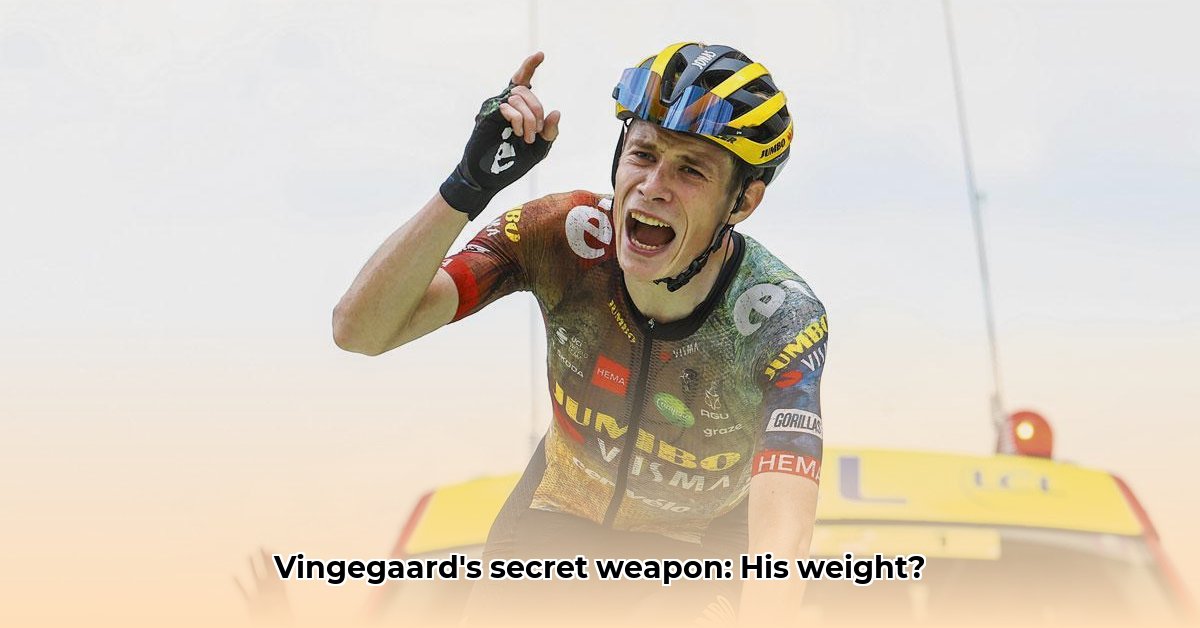
Jonas Vingegaard's Weight: A Winning Formula?
So, how much does Jonas Vingegaard weigh? While the exact figure remains a closely guarded secret, estimates hover around 58-60kg. But the number itself is less important than how he utilises that weight. It's not just about kilograms; it's about power-to-weight ratio – a key element in cycling success. Think of it like this: a lighter bike climbs faster, and a lighter, powerful cyclist is a force to be reckoned with on those gruelling climbs. This is why Vingegaard's precise weight remains a closely held secret – it's part of his tactical competitive advantage. How does this relate to his race strategy? We'll explore that further.
More Than Muscle: Efficiency on Two Wheels
Vingegaard’s success isn't solely about raw power; it's about efficiency. His weight contributes to his remarkable climbing ability. Each pedal stroke is deliberate; there's no wasted energy. He's the epitome of a finely tuned racing machine – light, yet incredibly powerful, allowing him to conquer those monstrous inclines with seemingly effortless grace. "It's a masterful blend of physical prowess and strategic race smarts," says Dr. Sarah Evans, Sports Physiologist at Stellenbosch University. How significant is this efficiency in achieving victory? The data suggests it's a major factor.
Data-Driven Dominance: Vingegaard's Impressive Stats
While exact weight remains elusive, Vingegaard's performance statistics paint a clearer picture. He consistently ranks within the top five in the Pro Cycling Stats (PCS) rankings, demonstrating his all-around prowess. His impressive 38 career wins speak volumes. In 2023 alone, he accumulated a staggering 2715 PCS points—a remarkable feat. These numbers aren't just about chance; they signify dedication, talent, and astute race strategy. How did he achieve these incredible statistics despite the challenges inherent in cycling?
Teamwork Makes the Dream Work: The Jumbo-Visma Advantage
Vingegaard's success is a team effort. Team Jumbo-Visma's meticulous planning, intense training regimes, and unparalleled support during races are crucial. They are the unsung heroes, ensuring he's always in peak condition and strategically positioned for optimal performance. "The team's contribution is immeasurable," explains Pieter van der Westhuizen, a former pro cyclist and current Cycling Analyst at a leading South African sports publication. But how much does this team synergy influence his overall success rate?
The Equipment Edge: Cervelo Bikes and Peak Performance
Vingegaard's choice of Cervelo bikes (R5 and S5 models) speaks volumes. These aren't just bikes; they're precision instruments, meticulously selected to enhance his climbing capabilities and speed. This detail-oriented approach underscores his commitment to optimal performance. It’s not just about the power; it’s about using all technology available to its utmost potential. Therefore, his equipment choice is a crucial part of his overall strategy.
The Ongoing Challenge: Maintaining Top Performance
Staying at the top of professional cycling is an ongoing battle. Competition is fierce, injuries are a constant threat, and maintaining peak fitness is incredibly demanding. Vingegaard faces numerous challenges in the years ahead. His team will need to carefully manage his training programme, balancing pushing his limits with injury prevention. What future adjustments will they make to uphold their winning strategy? This remains to be seen.
Beyond the Weight: A Legacy in the Making
Ultimately, Vingegaard's weight is just one piece of the puzzle. His incredible accomplishments aren't solely about a number on a scale; they're a testament to years of dedication, exceptional talent, calculated race planning, cutting-edge technology, and unwavering team support. He embodies the multi-faceted nature of winning in professional cycling – it's much more than just physical attributes. How will future cyclists learn from his strategies? This is a lasting question for the cycling world.
How Vingegaard’s Training Regime Fuels His Tour de France Victories
Key Takeaways:
- Vingegaard’s training prioritizes high-volume base training, building immense endurance.
- His exceptional VO2 max is a key factor in his mountain stage dominance, a combination of genetics and training.
- Preventing injury and maintaining training consistency is paramount for sustained success.
- Data-driven training plans, informed by physiological data, are crucial for peak performance.
Oxygen Powerhouse: VO2 Max and Endurance
Vingegaard's incredible aerobic capacity, measured by his VO2 max, is a major contributing factor. This metric assesses the body's oxygen utilization. His reported high VO2 max allows him to sustain incredible power output during lengthy climbs. This wasn’t achieved by chance; it's the result of years of rigorous training. Think of VO2 max as engine horsepower – Vingegaard's is a finely tuned engine.
Base Building: The Foundation of Endurance
Vingegaard's training philosophy centers on consistent, high-volume base training – accumulating miles to build endurance gradually. This contrasts with Tadej Pogačar’s more race-heavy strategy. This method builds resilience and mental fortitude, crucial for a three-week Grand Tour. "This base building approach ensures he's available and ready to compete at the highest levels without burnout," explains Professor Willem Jordaan, Exercise Scientist, University of Pretoria. How vital is this long-term approach for consistent success in cycling?
Injury Prevention: A Crucial Element of Success
Injury prevention is paramount. Vingegaard’s team meticulously plans training, carefully monitoring physiological data to minimize risks. "Consistent preparation and attention to injury prevention are crucial," says Dr. Evans. Maintaining consistency is a vital factor in achieving success.
Data-Driven Training: Personalization for Peak Performance
Vingegaard's success highlights the power of data-driven training plans. His training is tailored to his physiological metrics, optimizing his performance. What can aspiring cyclists learn from this approach? The importance of using physiological data to craft a personalized training plan cannot be overstated.
Actionable Steps for Cyclists of All Levels
- Prioritize base building: Accumulate miles consistently to build a solid endurance foundation.
- Use data-driven insights: Tailor training plans based on physiological metrics.
- Prioritize injury prevention: Prevention strategies are crucial for long-term success.
- Develop a long-term strategy: Plan training for sustained success, aiming for long-term goals.
This approach emphasizes sustainable success, not just short-term wins. How can aspiring cyclists adopt this approach for their own training? Careful planning and dedication are key.